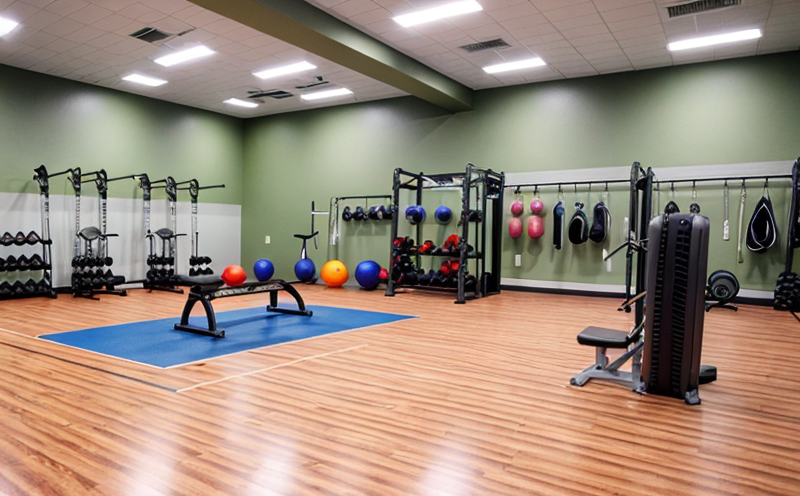Abrasion Resistance Testing of Fitness Equipment Surfaces
The abrasion resistance testing of fitness equipment surfaces is a critical process that ensures durability and safety in consumer products. As consumers demand more robust, long-lasting exercise equipment, the need for rigorous testing has become paramount. This service involves subjecting various materials used on fitness equipment to controlled abrasive wear to evaluate their resistance against friction and erosion. The abrasion resistance test helps manufacturers identify potential weak spots or areas that may require improvement in design or material selection.
There are several factors that contribute to the effectiveness of this testing process. One key aspect is the choice of abrasive materials used during the test, which can significantly influence results. Typically, standardized abrasive wheels made from diamond or silicon carbide are employed according to international standards such as ISO 4649 and ASTM D7803. These abrasives mimic real-world wear conditions while maintaining consistency across tests.
Another important consideration is the type of equipment being tested; different types of fitness machines may have varying surface materials due to their intended use. For example, treadmills often feature rubber mats that need exceptional abrasion resistance because they come into frequent contact with users' feet during extended periods of operation. On the other hand, elliptical trainers might opt for softer polyurethane coatings since they experience less direct foot contact compared to treadmills.
Proper specimen preparation is also crucial when performing these tests. Specimens must be cut from actual production samples rather than laboratory-manufactured pieces to ensure accurate representation of how the final product will perform under real conditions. Additionally, specimens should undergo any necessary pre-treatment steps like cleaning or conditioning prior to testing in order to eliminate external variables that could affect results.
The instrumentation used for this type of test includes specialized machines designed specifically for measuring abrasion loss over time. These devices apply consistent pressure and speed settings throughout the duration of each trial, ensuring reproducible data points. Commonly utilized equipment includes pin-on-disk testers (ISO 4649), rotating drum abrasion testers (ASTM D7803), and three-body wear testers (EN ISO 12947).
Once testing is complete, results are typically reported based on weight loss measurements or visual inspections for significant surface damage. Compliance with relevant standards such as ISO 4649 or ASTM F1515 provides assurance that the tested materials meet industry expectations regarding durability and performance.
To summarize, abrasion resistance testing of fitness equipment surfaces plays an essential role in ensuring high-quality products capable of standing up to daily use without compromising safety. By following established methodologies outlined by recognized standards bodies, laboratories can deliver reliable data that helps manufacturers improve their designs and materials choices for better overall product performance.
Applied Standards
Why Choose This Test
Abrasion resistance testing is vital for ensuring the longevity and safety of fitness equipment. Without it, manufacturers risk releasing products that fail prematurely due to insufficient material durability or improper design decisions. By investing in comprehensive abrasion tests early on in the development process, companies can avoid costly recalls later down the line while enhancing brand reputation through improved product quality.
Furthermore, compliance with relevant international standards like ISO 4649 and ASTM D7803 demonstrates a commitment to maintaining industry best practices. This not only protects brands from potential legal issues but also fosters customer confidence by showcasing adherence to recognized benchmarks for excellence.
In today’s competitive market where consumer expectations are constantly evolving, choosing this type of testing allows businesses to stay ahead of the curve by offering superior products that outperform competitors. It enables them to introduce innovative features or upgrades based on feedback from abrasion resistance data without sacrificing core functionality.
Competitive Advantage and Market Impact
- Innovation Lead Time: Early identification of material weaknesses allows manufacturers to innovate faster by exploring alternative solutions before problems become critical issues.
- Better User Experience: Higher abrasion resistance means longer-lasting equipment, reducing maintenance costs for both consumers and commercial gyms.
- Brand Reputation: Consistent high-quality performance builds trust with customers who value reliability and safety in their purchases.
- Increased Market Share: By offering more durable products than competitors, companies can capture a larger share of the market by attracting price-sensitive buyers looking for cost-effective yet reliable options.
Overall, incorporating abrasion resistance testing into the product development cycle provides significant competitive advantages that translate directly into increased profitability and long-term growth within the fitness equipment industry.





